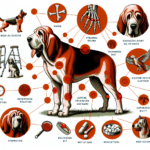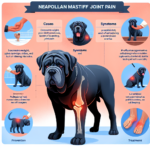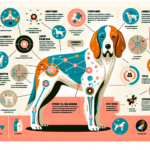Bloodhound Joint Pain: Causes, Symptoms, Prevention, and Treatment

Introduction
Bloodhounds are a distinctive and ancient breed, renowned for their exceptional sense of smell and tracking abilities. Originating from medieval France, Bloodhounds were initially bred for hunting deer and wild boar. Over time, their unparalleled scent-tracking skills made them invaluable in search and rescue operations, as well as in law enforcement. Characterized by their long, droopy ears, wrinkled skin, and soulful eyes, Bloodhounds are not only hardworking but also gentle and affectionate companions.
Despite their many admirable qualities, Bloodhounds are prone to several health issues, one of the most significant being joint pain. This article delves into the causes, symptoms, prevention, and treatment of joint pain in Bloodhounds, providing a comprehensive guide for owners to ensure their pets lead healthy, pain-free lives.
Breed-Specific Joint Pain Risks
Genetic Predisposition
Bloodhounds have a genetic predisposition to several joint-related issues, including hip dysplasia, elbow dysplasia, and arthritis. Hip dysplasia, a condition where the hip joint doesn’t fit into the hip socket properly, is particularly common in this breed. This genetic trait can lead to significant pain and mobility issues if not managed appropriately.
Age-Related Risks
As Bloodhounds age, the risk of developing joint pain increases. Typically, signs of joint issues may start to appear as early as five to six years of age. Owners should be vigilant about monitoring their Bloodhounds for any signs of discomfort or mobility issues as they enter their senior years.
Activity Level and Joint Stress
Bloodhounds are active dogs that require regular exercise to stay healthy. However, their high activity levels can also contribute to joint stress, especially if they are involved in strenuous activities like tracking or hunting. It’s crucial to balance their need for exercise with the potential risk of joint damage.
Common Symptoms of Joint Pain in Bloodhounds
General Symptoms
- Limping: One of the most noticeable signs of joint pain is limping or favoring one leg over another.
- Stiffness: Bloodhounds may show stiffness, especially after resting or sleeping.
- Reluctance to Move: A dog in pain may be hesitant to engage in activities they once enjoyed, such as running or climbing stairs.
- Swelling: In some cases, the affected joints may appear swollen or warm to the touch.
- Behavioral Changes: Pain can lead to changes in behavior, such as irritability or aggression.
Breed-Specific Symptoms
In Bloodhounds, joint pain may also manifest as a reluctance to track or follow scents, which is a significant deviation from their natural behavior. Additionally, due to their size and weight, Bloodhounds may show more pronounced symptoms of joint pain compared to smaller breeds.
When to Consult a Vet
If you notice any of the above symptoms in your Bloodhound, it’s essential to consult a veterinarian promptly. Early diagnosis and intervention can significantly improve the quality of life for dogs suffering from joint pain.
Preventive Measures for Joint Health
Exercise Recommendations
Regular, moderate exercise is crucial for maintaining joint health in Bloodhounds. Activities like walking, swimming, and gentle play are excellent options. Avoid high-impact exercises that can put excessive strain on their joints. It’s also beneficial to provide a mix of physical and mental stimulation to keep them engaged without overexerting their joints.
Dietary Suggestions
A balanced diet rich in essential nutrients can support joint health. Consider incorporating foods or supplements that contain glucosamine, chondroitin, and omega-3 fatty acids, which are known to promote joint health. Always consult your veterinarian before adding any supplements to your dog’s diet.
Weight Management
Maintaining a healthy weight is crucial for reducing joint stress. Bloodhounds are prone to obesity, which can exacerbate joint issues. Regularly monitor your dog’s weight and adjust their diet and exercise routine as needed to keep them at an optimal weight.
Early Screening and Monitoring
Regular veterinary check-ups are essential for early detection of joint issues. Bloodhounds may benefit from specific screening tests, such as X-rays or joint fluid analysis, to identify potential problems before they become severe. Early intervention can make a significant difference in managing joint health.
Treatment Options for Joint Pain
Non-Surgical Treatments
Non-surgical treatments for joint pain in Bloodhounds include medications, physical therapy, and lifestyle adjustments. Anti-inflammatory drugs and pain relievers can help manage symptoms, while physical therapy can improve mobility and strengthen muscles around the joints. Lifestyle adjustments, such as providing a comfortable resting area and avoiding high-impact activities, can also alleviate pain.
Surgical Options
In severe cases, surgical intervention may be necessary. Common surgical options include hip replacement, arthroscopy, and joint fusion. These procedures can provide significant relief and improve the quality of life for Bloodhounds suffering from severe joint pain. Consult with a veterinary orthopedic specialist to determine the best course of action for your dog.
Alternative Therapies
Alternative treatments like acupuncture, hydrotherapy, and massage can also benefit Bloodhounds with joint pain. Acupuncture can help reduce pain and inflammation, while hydrotherapy provides low-impact exercise that can improve joint mobility. Massage therapy can relieve muscle tension and improve circulation, promoting overall joint health.
Lifestyle and Management Tips
Daily Care Routine
A consistent daily care routine can help manage and alleviate joint pain in Bloodhounds. This routine might include gentle exercise, a balanced diet, and regular grooming to monitor for any changes in their condition. Providing a comfortable resting area with orthopedic beds can also make a significant difference.
Modifying the Home Environment
Making your home more accessible for a Bloodhound with joint pain can improve their quality of life. Consider installing ramps to help them navigate stairs and providing non-slip mats to prevent falls. Orthopedic beds can offer additional support and comfort for their joints.
Long-Term Management
Long-term management of joint pain involves regular veterinary check-ups, ongoing weight management, and consistent exercise. Monitoring your Bloodhound’s condition and making necessary adjustments to their care routine can help them stay active and happy despite joint pain.
FAQs About Bloodhounds and Joint Pain
What are the early signs of joint pain in Bloodhounds?
Early signs of joint pain in Bloodhounds include limping, stiffness, reluctance to move, and behavioral changes such as irritability or aggression. If you notice any of these symptoms, consult your veterinarian promptly.
Can diet help prevent joint pain in Bloodhounds?
Yes, a balanced diet rich in essential nutrients like glucosamine, chondroitin, and omega-3 fatty acids can support joint health and potentially prevent joint pain. Always consult your veterinarian before adding any supplements to your dog’s diet.
How much exercise is appropriate for a Bloodhound with joint pain?
Moderate, low-impact exercise such as walking and swimming is ideal for Bloodhounds with joint pain. Avoid high-impact activities that can exacerbate joint issues. Consult your veterinarian for personalized exercise recommendations.
Are there any specific breeds that Bloodhounds are more prone to joint pain compared to?
Bloodhounds are particularly prone to joint pain due to their size and genetic predisposition. While other large breeds like German Shepherds and Labrador Retrievers also face similar issues, Bloodhounds’ unique build and activity levels make them especially susceptible.
Conclusion
Joint pain is a significant concern for Bloodhound owners, but with proper care and attention, it can be managed effectively. By understanding the causes, symptoms, and preventive measures, owners can take proactive steps to ensure their Bloodhounds lead healthy, pain-free lives. Regular veterinary check-ups, a balanced diet, appropriate exercise, and a supportive home environment are crucial components of joint health management. By staying informed and vigilant, you can help your Bloodhound enjoy a happy and active life despite the challenges of joint pain.




